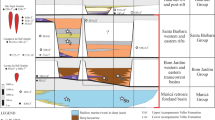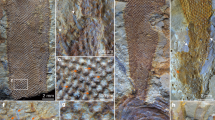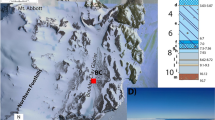Abstract
THE discovery of assemblages of unicellular, colonial and multiunit (endosporangium-like) algal microfossils in thin sections and in macerations of carbonaceous cherts and dolomitic limestones from the late Precambrian Brioverian ‘Series’ of northwestern France is reported here. These assemblages represent new links in the now rapidly expanding known record of Precambrian life. They are of interest because of (1) their similarity to microbiotas of comparable age reported from Canada and Alaska, a similarity suggesting that such assemblages could prove useful for global biostratigraphic correlation of late Precambrian strata; (2) their presence in partially metamorphosed sediments, an occurrence indicating that Precambrian organic-walled microfossils may not be as susceptible to metamorphic alteration as has widely been assumed; (3) one of the assemblages is preserved in carbonates, a facies previously little studied by Precambrian micropalaeontologists.
This is a preview of subscription content, access via your institution
Access options
Subscribe to this journal
Receive 51 print issues and online access
$199.00 per year
only $3.90 per issue
Buy this article
- Purchase on Springer Link
- Instant access to full article PDF
Prices may be subject to local taxes which are calculated during checkout
Similar content being viewed by others
References
Auvray, B. 2ème Réunion annuelle des Sciences de la Terre, 22 (1974).
Vidal, P. thesis, Univ. Rennes (1976).
Adams, C. J. thesis, Univ. Oxford (1967).
Auvray, B. & Vidal, P. 1re Réunion annuelle des Sciences de la Terre, 54 (1973).
Schopf, J. W. Precambrian Res. 5, 143–173 (1977).
Schopf, J. W. & Prasad, K. N. Precambrian Res. 6, 347–366 (1978).
Roblot, M. M. thesis, Univ. Paris (1968); C.r. hebd. Séance. Acad. Sci., Paris 256, 1557–1559 (1963), 264, 1263–1265 (1967); Annls. Paléont. 50, 105–110 (1964); Revue Micropaléont. 7, 153–156 (1964).
Graindor, M. J. C.r. hebd. Séanc. Acad. Sci., Paris 244, 2075–2077 (1957).
Deflandre, G. C.r. somm. Soc. géol. Fr., 182–184 (1955); C.r. hebd. Séanc. Acad. Sci., Paris 266, 2385–2389 (1968).
Pacltova, B. Cas. Miner. Geol. 17, 357–363 (1972).
Moorman, M. J. Paleont. 48, 524–539 (1974).
Allison, C. W. & Moorman, M. Geology 1, 65–68 (1973).
Kalliokoski, J. Geology 2, 26–27 (1974).
Allison, C. W. & Moorman, M. Geology 2, 202–203 (1974).
Timofeev, B. B. Proc. 3rd Int. Palynological Conf., 7–12 (Nauka, Moscow, 1973).
Nagy, L. A. J. Paleont. 52, 141–154 (1978).
Author information
Authors and Affiliations
Rights and permissions
About this article
Cite this article
CHAUVEL, J., SCHOPF, J. Late Precambrian microfossils from Brioverian cherts and limestones of Brittany and Normandy, France. Nature 275, 640–642 (1978). https://doi.org/10.1038/275640a0
Received:
Accepted:
Issue Date:
DOI: https://doi.org/10.1038/275640a0
This article is cited by
-
Late Proterozoic Brioverian microfossils from France: taxonomic affinity and implications of plankton productivity
Nature (1983)
-
Aromatic free radicals in the gunflint chert
Naturwissenschaften (1982)
Comments
By submitting a comment you agree to abide by our Terms and Community Guidelines. If you find something abusive or that does not comply with our terms or guidelines please flag it as inappropriate.



